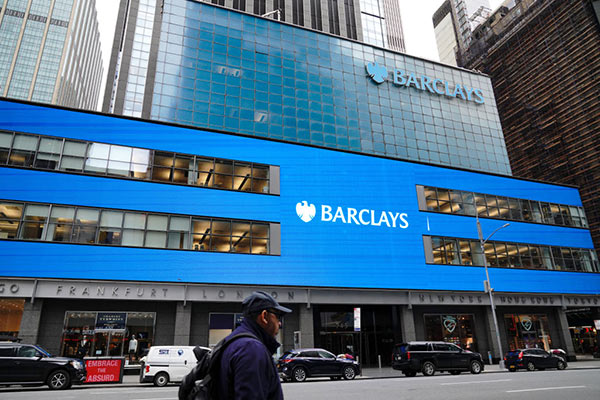Barclays shares surge as ambitious new plan unveiled
A fresh wave of optimism engulfing the UK banking sector has extended to Barclays following its annual results and strategic update. ii's head of markets explains why the share price is at its highest since early October.
20th February 2024 08:43
by Richard Hunter from interactive investor

These annual results from Barclays (LSE:BARC) are something of a curate’s egg, hindered by a weak final quarter, but at the same time a fresh strategic update has laid the groundwork for some rather more ambitious and profitable results over the next three years.
An investor update presentation follows later for the group, but the results give some clues as to the likely highlights.
- Invest with ii: Open a Stocks & Shares ISA | ISA Investment Ideas | Transfer a Stocks & Shares ISA
A Return on Tangible Equity (ROTE) of more than 10% is to be targeted this year, rising to over 12% in 2026. Capital distributions for the three years 2024, 2025 and 2026 are likely to total £10 billion, largely weighted towards share buybacks, which should provide some share price support.
At the same time, the group is being split into the five operating divisions of Barclays UK, Barclays UK Corporate Bank, Barclays Private Bank and Wealth Management, Barclays Investment Bank and Barclays US Consumer Bank. While further colour will no doubt be provided, the divisions of labour appear to make sound strategic sense at first glance.
In the meantime, the numbers are dragged lower by a cumulative £1 billion of “structural cost actions” which the bank has taken to streamline activities across people, infrastructure and property, resulting in costs which are expected to be repaid within two years. These actions are in line with the broader strategy to improve performance, drive higher returns and provide “predictable, attractive shareholder distributions”.
Pre-tax profit for the year of £6.6 billion compares with £7 billion in the corresponding period, where a further credit impairment takes the cumulative figure to £1.9 billion in addition to the short-term drag of the cost actions.
Total group income rose by 2% to £25.4 billion, although the fourth-quarter contribution of £5.6 billion was shy of the expected £5.8 billion. Net Interest Income jumped by 20% to £12.7 billion, with higher interest rates continuing to provide a tailwind, although the Net Interest Margin remains an area of concern.
- Sign up to our free newsletter for investment ideas, latest news and award-winning analysis
- NatWest makes massive profit and boosts dividend
Other key metrics are also a mixed bag, although they continue to point to the financial strength in depth of the group. A ROTE of 10.6% was a slight decrease from the previous 11.6%, although the capital cushion, or CET1 ratio, remains comfortably in excess of regulatory requirements at 13.8%. The Liquidity Coverage Ratio also ticked higher to 161% from 159%, with an overall cost/income ratio of 63%.
The strength has enabled the announcement of a further share buyback of £1 billion and an incremental increase to the dividend which leads to an attractive projected yield of 5.4%.
Within the units, the themes of previous quarters were largely repeated The Corporate and Investment Bank (CIB), which accounts for around half of total group revenue, saw a dip of 6% in income to £12.6 billion for the year. Lower client activity and investment fees, the latter of which reflects a reduced fee banking pool as experienced by some of the bank’s US counterparts, dragged on numbers although CIB managed a ROTE of 8.9%.
On the other hand, Consumer Cards and Payments (CC&P) saw income rise by 18% to £5.3 billion, although the higher activity particularly in US credit cards, came with something of a caveat, This rise in effectively unsecured lending has inevitably led to a small and containable increase in credit defaults, of which the bank is acutely aware. It has therefore taken the decision to increase the overall level of the impairment charge to £1.5 billion for the year, which is an additional £200 million provision from the third quarter, reflecting the expected higher level of delinquencies in US cards.
- 10 hottest ISA shares, funds and trusts: week ended 16 February 2024
- eyeQ: 10 actionable trading signals for week beginning 19 Feb 2024
- Spring Budget 2024 preview: what might we expect?
The initial share price reaction is one of eager anticipation over the bank’s new and ambitious plans, despite a mixed performance over the last year. The price hike also undoes some of the damage wrought of late, where prior to these results the shares had dropped by 14% over the last year, as compared to a dip of 3.6% for the wider FTSE100.
It remains to be seen whether this fresh wave of optimism will be fulfilled, but in the meantime Barclays is a group with deep pockets and a diversified business model which is enough to tip the scales, leading to a market consensus which comes in at a 'cautious buy'.
These articles are provided for information purposes only. Occasionally, an opinion about whether to buy or sell a specific investment may be provided by third parties. The content is not intended to be a personal recommendation to buy or sell any financial instrument or product, or to adopt any investment strategy as it is not provided based on an assessment of your investing knowledge and experience, your financial situation or your investment objectives. The value of your investments, and the income derived from them, may go down as well as up. You may not get back all the money that you invest. The investments referred to in this article may not be suitable for all investors, and if in doubt, an investor should seek advice from a qualified investment adviser.
Full performance can be found on the company or index summary page on the interactive investor website. Simply click on the company's or index name highlighted in the article.